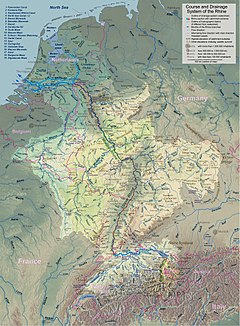
Rhine
Major river in Western Europe / From Wikipedia, the free encyclopedia
Dear Wikiwand AI, let's keep it short by simply answering these key questions:
Can you list the top facts and stats about Rhine?
Summarize this article for a 10 years old
The Rhine[note 2] (/raɪn/ RYNE)[3] is one of the major European rivers. The river begins in the Swiss canton of Graubünden in the southeastern Swiss Alps. It forms part of the Swiss-Liechtenstein, Swiss-Austrian, and Swiss-German borders. After that the Rhine defines much of the Franco-German border, after which it flows in a mostly northerly direction through the German Rhineland. Finally in Germany, the Rhine turns into a predominantly westerly direction and flows into the Netherlands where it eventually empties into the North Sea. It drains an area of 9,973 sq km and its name derives from the Celtic Rēnos. There are also two German states named after the river, North Rhine-Westphalia and Rhineland-Palatinate.
| Rhine | |
|---|---|
 The Rhine in Basel, Switzerland | |
 Map of the Rhine basin | |
| Etymology | Celtic Rēnos |
| Native name |
|
| Location | |
| Countries | |
| Rhine Basin |
|
| Region | Central and Western Europe |
| Largest cities | |
| Physical characteristics | |
| Source | Rein Anteriur/Vorderrhein |
| • location | Tomasee (Romansh: Lai da Tuma), Surselva, Graubünden, Switzerland |
| • coordinates | 46°37′57″N 8°40′20″E |
| • elevation | 2,345 m (7,694 ft) |
| 2nd source | Rein Posteriur/Hinterrhein |
| • location | Paradies Glacier, Graubünden, Switzerland |
| Source confluence | Reichenau |
| • location | Tamins, Graubünden, Switzerland |
| • coordinates | 46°49′24″N 9°24′27″E |
| • elevation | 585 m (1,919 ft) |
| Mouth | North Sea |
• location | Netherlands |
• coordinates | 51°58′54″N 4°4′50″E |
• elevation | 0 m (0 ft) |
| Length | 1,230 km (760 mi)[note 1] |
| Basin size | 185,000 km2 (71,000 sq mi) |
| Discharge | |
| • average | 2,900 m3/s (100,000 cu ft/s) |
| • minimum | 800 m3/s (28,000 cu ft/s) |
| • maximum | 13,000 m3/s (460,000 cu ft/s) |
| [2] | |
The International Commission for the Hydrology of the Rhine Basin (CHR) and EUWID contend that the river could experience a massive decrease in volume, or even dry up completely, within the next 30 to 80 years, as a result of the climate crisis.[4][5]
Rhine is the second-longest river in Central and Western Europe (after the Danube), at about 1,230 km (760 mi),[note 1] with an average discharge of about 2,900 m3/s (100,000 cu ft/s).
The Rhine and the Danube comprised much of the Roman Empire's northern inland boundary, and the Rhine has been a vital navigable waterway bringing trade and goods deep inland since those days. The various castles and defenses built along it attest to its prominence as a waterway in the Holy Roman Empire. Among the largest and most important cities on the Rhine are Cologne, Rotterdam, Düsseldorf, Duisburg, Strasbourg, Arnhem, and Basel.